Forward Collision-Avoidance Assist operation
Basic function
The basic function for Forward Collision-Avoidance Assist is warned and controlled by the following level.
-
Collision warning
-
Emergency braking
-
Stopping vehicle and ending brake control
Collision warning

A: Collision Warning
Collision warning will alert the driver with a Forward safety warning light ( ), a warning message, and an audible warning.
), a warning message, and an audible warning.
Collision Warning will be activated under the following conditions depending on the target ahead.
Your driving speed:
-
For vehicle or powered two-wheeler: Approximately 6~124 mph (10~200 km/h)
-
For pedestrian or cyclist: Approximately 6~53 mph (10~85 km/h)
Emergency braking

A: Emergency Braking
Emergency braking will alert the driver with a Forward safety warning light ( ), a warning message, and an audible warning. The brake assist will be activated to help avoid a collision with a vehicle,
pedestrian or cyclist.
), a warning message, and an audible warning. The brake assist will be activated to help avoid a collision with a vehicle,
pedestrian or cyclist.
Emergency braking will be activated under the following conditions: your driving speed conditions, depending on the target ahead and the level of risk.
-
For vehicle or powered two-wheeler:
Driving target
Stopped target
Weak braking power
Approximately 6~124 mph (10~200 km/h)
Strong braking power
Approximately 6~80 mph (10~130 km/h)
Approximately 6~47 mph (10~75 km/h)
Strong braking power - (if equipped)*
Approximately 6~62 mph (10~100 km/h)
-
(if equipped)*: If Forward Collision-Avoidance Assist judges that avoiding collision is difficult even by changing the driving lane due to surroundings of the vehicle, it assists braking at an earlier time.
-
-
For pedestrian or cyclist: Approximately 6~40 mph (10~65 km/h)

The function operation range may decrease due to the front traffic condition or the surroundings of the vehicle.
Stopping vehicle and ending brake control

A: Drive carefully
When the vehicle is stopped due to emergency braking, the warning message will appear on the cluster.
For your safety, the driver should depress the brake pedal immediately and check the surroundings.
-
Brake control will end after the vehicle is stopped by emergency braking for approximately 2 seconds.
Junction Turning function
The Junction turning function is warned and controlled by the following level.
-
Collision warning
-
Emergency braking
-
Stopping vehicle and ending brake control
Collision warning
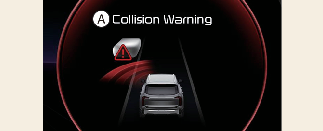
A: Collision Warning
Collision warning will alert the driver with a Forward safety warning light ( ), a warning message, an audible warning, and steering wheel vibration.
), a warning message, an audible warning, and steering wheel vibration.
Collision warning will be activated in the following conditions.
-
Your driving speed: Approximately 6~19 mph (10~30 km/h)
-
Oncoming vehicle or powered two wheeler speed: Approximately 19~44 mph (30~70 km/h)
Emergency braking
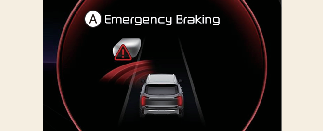
A: Emergency Braking
Emergency braking will alert the driver with a Forward safety warning light ( ), a warning message, an audible warning, and steering wheel vibration. The brake assist will be activated and to help avoid
a collision with an oncoming vehicle.
), a warning message, an audible warning, and steering wheel vibration. The brake assist will be activated and to help avoid
a collision with an oncoming vehicle.
Emergency braking will be activated in the following conditions.
-
Your driving speed: Approximately 6~19 mph (10~30 km/h)
-
Oncoming vehicle speed: Approximately 19~44 mph (30~70 km/h)
Stopping vehicle and ending brake control

A: Drive carefully
When the vehicle is stopped due to emergency braking, the warning message will appear on the cluster.
For your safety, the driver should depress the brake pedal immediately and check the surroundings.
-
Brake control will end after the vehicle is stopped by emergency braking for approximately 2 seconds.
Junction Crossing function (if equipped)
Warning and control
The Junction Crossing function is warned and controlled by the following level.
-
Collision warning
-
Emergency braking
-
Stopping vehicle and ending brake control
Collision warning


A: Collision Warning
Forward collision warning will alert the driver with a Forward safety warning light ( ), a warning message, an audible warning, and steering wheel vibration.
), a warning message, an audible warning, and steering wheel vibration.
Collision warning will be activated in the following conditions.
-
Your driving speed: Approximately 6~19 mph (10~30 km/h)
-
Crossing vehicle speed: Approximately 10~37 mph (15~60 km/h)
Emergency braking


A: Emergency Braking
Emergency braking will alert the driver with a Forward safety warning light ( ), a warning message, and an audible warning. The brake assist will be activated to help avoid a collision with an oncoming
vehicle.
), a warning message, and an audible warning. The brake assist will be activated to help avoid a collision with an oncoming
vehicle.
Emergency braking will be activated in following conditions.
-
Your driving speed: Approximately 6~19 mph (10~30 km/h)
-
Crossing vehicle speed: Approximately 10~37 mph (15~60 km/h)
Stopping vehicle and ending brake control

A: Drive carefully
When the vehicle is stopped due to emergency braking, the warning message will appear on the cluster.
For your safety, the driver should depress the brake pedal immediately and check the surroundings.
-
Brake control will end after the vehicle is stopped by emergency braking for approximately 2 seconds.

If the collision angle with the crossing vehicle is beyond a certain range, Junction Crossing Warning and control may be late or may not operate.

You can turn off the audible warning by pressing the hazard warning flasher during Collision warning or Emergency braking.
Lane-change oncoming function (if equipped)
Warning and control
The Lane-change oncoming function is warned and controlled by the following level.
-
Collision warning
-
Emergency steering
Collision warning

A: Collision Warning
Collision warning will alert the driver with a Steering warning light ( ), a warning message, an audible warning, and steering wheel vibration.
), a warning message, an audible warning, and steering wheel vibration.
Collision warning will be activated in the following conditions.
-
Your driving speed: Approximately 25~90 mph (40~145 km/h)
-
Oncoming vehicle speed: Approximately above 6 mph (10 km/h)
-
Relative speed: Approximately below 124 mph (200 km/h)
Emergency steering

A: Emergency Steering
Emergency steering will alert the driver with a Steering warning light ( ), a warning message, and an audible warning. The steering assist will be activated to help avoid a collision with an oncoming
vehicle or powered two-wheelers.
), a warning message, and an audible warning. The steering assist will be activated to help avoid a collision with an oncoming
vehicle or powered two-wheelers.
Emergency steering will be activated in following conditions.
-
Your driving speed: Approximately 25~90 mph (40~145 km/h)
-
Oncoming vehicle speed: Approximately above 6 mph (10 km/h)
-
Relative speed: Approximately below 124 mph (200 km/h)
Lane-change side function (if equipped)
Warning and control
The Lane-change side function is warned and controlled by the following level.
-
Collision warning
-
Emergency steering
Collision warning

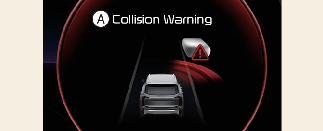
A: Collision Warning
Collision warning will alert the driver with a Steering warning light ( ), a warning message, an audible warning, steering wheel vibration.
), a warning message, an audible warning, steering wheel vibration.
Emergency steering will be activated in following conditions.
-
Your driving speed: Approximately 25~90 mph (40~145 km/h)
Emergency steering

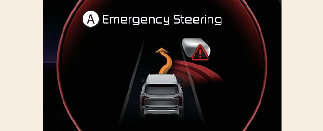
A: Emergency Steering
Emergency steering will alert the driver with a Steering warning light ( ), a warning message, an audible warning, and steering wheel vibration.
), a warning message, an audible warning, and steering wheel vibration.
Emergency steering will be activated in following conditions.
-
Your driving speed: Approximately 25~90 mph (40~145 km/h)
-
Vehicle or powered two-wheeler in the next lane: Driving

-
Lane-Change Side function does not operate if the oncoming vehicle from the front side is stopped.
-
The detecting area of front and rear corner radar is determined by a standard lane width of the standard road. The warning may appear from the vehicle driving in the next lane for narrow roads, or the warning may not appear due to not detecting a vehicle on the next lane for wide roads.
-
Lane change side function is deactivated in following conditions:
-
Approaching to next lane for standard amount of distance
-
Getting away from the collision hazard direction
-
Sharply steering the vehicle
-
Depressing the brake pedal
-
Forward Collision-Avoidance Assist is operating
-
-
After Lane change side function is activated or lane change is done, move your vehicle to the center of the lane afterwards.
Lane change side function will not operate when the vehicle is not being driven in the center of the lane.

If emergency steering is likely to cause additional collisions, the vehicle will alert the driver only with collision warning.
Evasive Steering Assist function (if equipped)
Warning and control
The Evasive Steering Assist function is warned and controlled by the following level.
-
Emergency Steering
Emergency Steering (Driver steering assist)
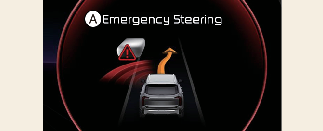

A: Emergency Steering
Emergency steering will alert the driver with a Steering warning light ( ), a warning message, an audible warning, and steering wheel vibration. If a possible collision with a vehicle, pedestrians,
cyclists, or powered two-wheeler is detected and the driver steers to avoid the collision, the vehicle will assist the driver
in steering.
), a warning message, an audible warning, and steering wheel vibration. If a possible collision with a vehicle, pedestrians,
cyclists, or powered two-wheeler is detected and the driver steers to avoid the collision, the vehicle will assist the driver
in steering.
Emergency Steering will be activated in following conditions.
-
Your driving speed: Approximately 25~53 mph (40~85 km/h)
Emergency Steering (Evasive steering assist)


A: Emergency Steering
Emergency steering will alert the driver with a Steering warning light ( ), a warning message, an audible warning, and steering wheel vibration. If there is a risk of collision with vehicles, pedestrians,
cyclists, or powered two wheelers in front and your vehicle already exceeded the emergency braking speed limit, the steering
will be assisted to help prevent collision when the driver steers the vehicle to avoid collision.
), a warning message, an audible warning, and steering wheel vibration. If there is a risk of collision with vehicles, pedestrians,
cyclists, or powered two wheelers in front and your vehicle already exceeded the emergency braking speed limit, the steering
will be assisted to help prevent collision when the driver steers the vehicle to avoid collision.
Emergency Steering will be activated in following conditions.
-
Your driving speed: Approximately 40~47 mph (65~75 km/h)

-
The steering wheel may turn automatically when emergency steering is operating.
-
Emergency steering will automatically cancel when risk factors disappear. If necessary, the driver must steer the vehicle.
-
Emergency steering may not operate or may cancel during operation if the steering wheel is held tight or steered in the opposite direction.
-
When steering is assisted to avoid collision with a vehicle, pedestrian and cyclist, Evasive steering assist will be canceled if collisions with other objects (vehicles, pedestrians, cyclists, or powered two-wheeler) are expected.
-
Evasive steering assist may not operate if space to avoid collision in the driving lane is insufficient.

For more details on warning messages, refer to More Details.

-
For your safety, change the Settings after parking the vehicle at a safe location.
-
Forward Collision-Avoidance Assist does not operate in all situations or cannot avoid all collisions.
-
The driver should hold the responsibility to control the vehicle. Do not solely depend on Forward Collision-Avoidance Assist. Rather, maintain a safe braking distance, and if necessary, depress the brake pedal to reduce driving speed or to stop the vehicle.
-
Never deliberately operate Forward Collision-Avoidance Assist on people, objects, etc. It may cause serious injury or death.
-
Forward Collision-Avoidance Assist may not operate if the driver depresses the brake pedal to avoid collision.
-
Depending on the road and driving conditions, Forward Collision-Avoidance Assist may warn the driver late or may not warn the driver.
-
During Forward Collision-Avoidance Assist operation, the vehicle may stop suddenly injuring passengers and shifting loose objects. Always have the seat belt on and keep loose objects secured.
-
If any other function's warning message is displayed or audible warning is generated, Forward Collision-Avoidance Assist warning message may not be displayed and audible warning may not be generated.
-
You may not hear the warning sound of Forward Collision-Avoidance Assist if the surrounding is noisy. Adjust the warning volume vehicle appropriately, and always be aware of the surroundings and drive safely.
-
Forward Collision-Avoidance Assist may turn off or may not operate properly or may operate unnecessarily depending on the road conditions and the surroundings.
-
Even if there is a problem with Forward Collision-Avoidance Assist, the vehicle's basic braking performance will operate properly.
-
During emergency braking, braking control by Forward Collision-Avoidance Assist will automatically cancel when the driver excessively depresses the accelerator pedal or sharply steers the vehicle.

-
The surroundings and pedestrians, cyclists, other vehicles, or powered two-wheelers in front of you may affect the speed or detection range to operate Forward Collision-Avoidance Assist, resulting in Forward Collision-Avoidance Assist being temporarily limited or disabled.
-
Forward Collision-Avoidance Assist will operate under certain conditions by determining the risk level depending on the surroundings and other vehicles' driving directions or speed.
-
Driving at excessively higher or lower speed than other vehicles can temporarily limit or disable Forward Collision-Avoidance Assist.
-
When a collision with a surrounding vehicle is expected, Lane-change oncoming, Lane-change side and Evasive steering assist functions will only warn the driver. (if equipped)

-
When a collision is imminent, the Forward Collision-Avoidance Assist may assist the driver with brakes if the driver fails to brake enough.
-
The images or colors may be displayed differently depending on the specifications of the instrument cluster or theme.